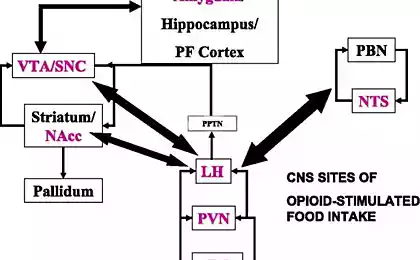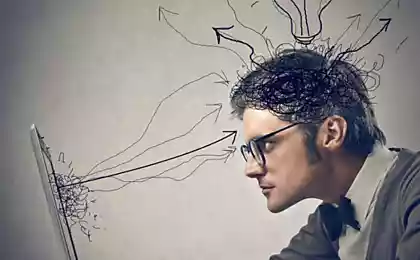775
The dopamine trap and swing
When we discuss dopamine, it is important not only the average number but also the base level and amplitude of oscillations. Today let's talk about the basic level of dopamine. This level defines the source fairly constant. The higher the baseline level, the higher the confidence, resilience and robustness to joy and to grief. The buildup of dopamine levels sharply up and down (stimulate dependency) leads to lowering of its base level.

Basal levels of dopamine, the dopamine trap and swing. Dopamine gives us a sense of strength, resilience, vitality and self-empowerment. Accordingly, the one who feels the lack of dopamine often suffer from apathy, weakness and languishing of depression. On the other hand, too much dopamine may cause anxiety, fear, excessive nervous tension, delusions and hallucinations. Anxiety caused by a surplus of dopamine and its derivative norepinephrine can hide under depression.
Baseline dopamine levels. The base level of dopamine is composed of many individual values. It and physical resources, and psychological and social. High baseline level of dopamine is a constant receiving of his of the many aspects of daily activities.
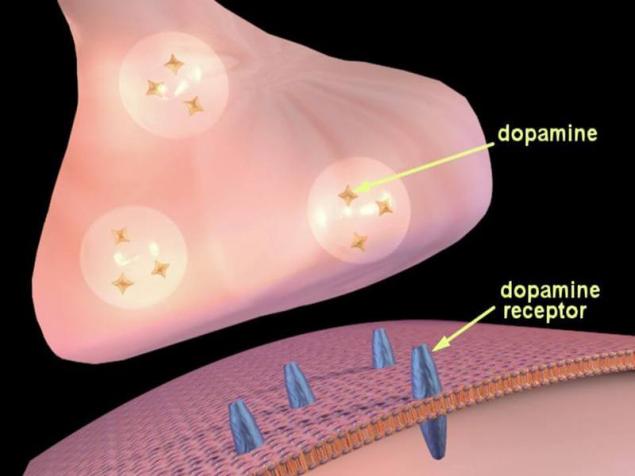
Our goal is lots of little incentives, evenly distributed throughout the day and "deserved". A healthy person gets the pleasure (dopamine) evenly throughout the day in small portions, as in schizophrenia or drug abuse, the flow of dopamine jumps jerky — all around a very bad and dark, a powerful surge of dopamine from the manic dreams, then bad again. It is necessary that a schizophrenic or a drug addict again learned to take joy in small but frequent injections. He needs to enjoy life, to look around like all people, find something interesting looking at the world and other people, to enjoy communication with people, books, movies, nature and good weather. Then the level of dopamine will be continuously maintained at a normal level small portions of joy and schizophrenic or drug addict will not have to leave in a dream or drug world for a breath of pleasure.
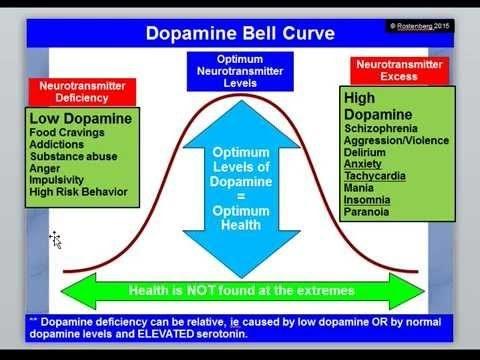
The problem of low and high baseline levels of dopamine. If you have chronically low dopamine, then you will not be motivated to do something at the chemical level of your brain. Neurologist John Salamon conducted a study on rats who were offered a choice of two piles of food. One was right in front of them, and second, the size twice, was behind a low fence. The rats with lowered levels of dopamine almost always go the easy route, chose a small handful of food, and tried to climb over the fence to get a greater reward.
In another study, a group of scientists compared the brains tenacious, adventurous man with the brain of a slacker. The researchers found that those who are willing to work for reward, there are high levels of dopamine in the prefrontal cortex and the striatum — two brain regions responsible for motivation and reward. But the slackers, dopamine was present in the anterior Insula region of the brain is the area responsible for emotions and risk perception.

"Low levels of dopamine make people and other animals work less for something, that is, he is more concerned with the motivation and analysis of costs and benefits than by pleasure," – said Salomone. Due to the action of dopamine a person decides for new achievements, discoveries, feats, and even madness. If the body lacks dopamine, the person becomes dull. The release of blood hormone occurs when a person engages in the activity, which allows to obtain him the real pleasure and enjoyment.
By reducing the basal level of dopamine occurs the so-called "syndrome of lack of remuneration," which is characterized by reduced basal levels of dopamine due to the insufficient capacity of the receptors, and this leads to the need for human factors that can cause increase levels of dopamine. In other words, low basal dopamine levels significantly increases the risk of addiction and addictive behavior.
Dopamine trap (drug or other stimulation). In fundamental scientific research, 1954, which was conducted by canadian scientists, James olds and Peter Milner was found that stimulation of certain areas of the brain, especially in the middle node of the forebrain, in laboratory mice using a low voltage electrical discharge through implanted into the brain electrodes cause delivering the rodents are really great fun. The scientists placed mice in a special box and let the mouse by pushing the lever stimulant much as they like.

And mouse of steel pushed the lever up to 1,000 times per hour (!), forgetting about food, sleep, and the baby almost dying from exhaustion. This gave grounds to assume that stimulated the "pleasure center". One of the main channels of transmission of nerve impulses in the brain — dopaminei, so the researchers put forward the theory that the main chemical associated with reward and pleasure is dopamine. Thus was discovered the "reward system" of the brain, the neurotransmitters are dopamine and serotonin. Mouse just turned into addicts who are addicted to dopamine. After scientists disabled the mouse the electrodes, it took a few weeks, so they stopped trying to put pressure on the lever samostimulyatsii and came to normal behavior. This experiment has become a classic in neuroscience, and has been repeatedly replicated and studied in various laboratories of the world.
Dopamine trap is a trap of constant self-stimulation. This is when a person stimulates itself and stimulates the drug to exhaustion, but did not reach the desired. This applies to overeating, drugs, likenew, repost, constant checking email, etc. the Essence of the loop that dopamine produces pleasure, not so much from getting the desired, how many from the search. Loop is when you do something for kicks, out of boredom, with no real need and no need. Once this neurotransmitter is associated with a psychological reward loop, the desire to get even more rewards and gets the comprehensive care of the brain.
The buildup of the dopamine of the boat. If possible, try to avoid surges of dopamine caused by drug signals. People smarter mouse, but sometimes he also wants to cheat nature and get a promotion the easy way by raising the level of dopamine artificially. Since dopamine is a neurotransmitter working in the brain, take it in pill or injections is not possible, because he will not pass the protective barriers of the cerebral cortex. However, there are chemical substances that increase dopamine levels indirectly, for example, all drugs (including alcohol and nicotine) and some antidepressants.
A productive phase. It is based on everything that artificially increases the level of dopamine: drugs, insomnia, video games, surfing the Internet, savoring their fantasies, dopamine food, porn, Masturbation, and more. Conventionally, call it all drugs, but the person who spends a lot of time on these things – a drug addict.

When taking drugs, dopamine accumulates in the synaptic space, and not removed from it in time. Instead, he again attaches to the receptors of the host cell, and an electric signal of encouragement is amplified and transmitted again and again. So what happens when artificially increasing the level of dopamine? Of course the failure of the "system of incentives". The brain can no longer correctly decide what is good and what is bad. Sensations bring more pleasure than usual, the colors are beautiful and bright, hands-free voice and rich timbre, any Association seem to be possible and reliable. Almost any first came the thought seems correct and interesting. The brain becomes harder to switch to events coming from the real world, because on the inside everything suddenly became so interesting and important.
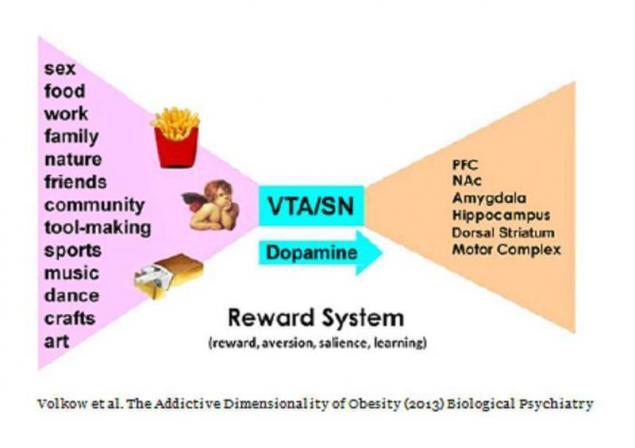
The negative phase. After the action of the drug there is a sharp drop in the level of neurotransmitters, anxiety and remorse, why the levels of neurotransmitters falls below normal. The addict from experiencing this frustration, and after a while it is all great joy to bring memories of "buzz", and he again reach for the drug...
Gradually more and more drugs will be associated in the memory with pleasure (i.e., dopamine), and it will be harder to refuse them by counter-arguments. If the addict will not stop this sad cycle, that in real life start problems (loss of job, friends, family). From the heavy thoughts about hard problems, the level of dopamine will decrease even more, and the drugs will look even more attractive against the background of faded reality. Spoiled dopamine, the brain is not considered natural pleasure (food, sex, socializing with others) as due reward. They will begin to associate rather unpleasant memories (loss of social status, rejection by society, impotence, loss of taste of food, etc.). Drugs gradually become less happy, and a way to somehow escape from problems and a little to cheer yourself up.
In the negative phase, too, is a "negative self-stimulation", just move it already not the man himself and the external circumstances: the more problems arise after the psychosis, the more unpleasant thoughts appear, what bowl they arise, the more there with them negative associations. Gradually the mere mention of the problem or one look at its associated object can spoil the mood of the person for the whole day. The person becomes depressed, it is fenced off from society, loses his job, family, friends, etc. because Of this, it becomes even more problems, and the world becomes even more bleak. The fall in base level.So productive phase of stimulation may go into negative and then Vice versa — if dopamine levels remain below normal, the addict reaches for a new dose, and the schizophrenic will go again in a dream world for a breath of dopamine. Productive and negative phases are closely related, and rocking dopamine levels as the swing. To stop this and allow the dopamine to normal, a person must control his thoughts and actions in order to prevent excessive increase of dopamine in the productive phase and excessive lowering during negative.

Basal levels of dopamine, the dopamine trap and swing.
With the continued build-up there is a drop in baseline dopamine due to destruction of dopamine neurons, and reduced sensitivity of dopamine receptors due to the constant excitation and stimulation. The "reward system" gradually adapts to the excessive flow of dopamine and reduces the number of active receptors to protect your cells from over-voltage. Thus the former dose of the drug did not bring the pleasure it used to be, and the addict is forced to increase the dosage to experience the old feeling.
The middle way (high basic level without spikes). In detail about it I still will write a brief while. In Buddhism (the main religion of China and South-East Asia), even there is a whole doctrine of "Four noble truths" that suffering and depression are an integral part of life, and the fact they are from unsatisfied desires, that is to get rid of depression you need to reduce or dismiss the desire, but it is important to find your "Golden mean" and the right to separate the necessary from the unnecessary desires. Thus, controlling their thoughts, passions and desires, man can hold the "middle way", ie not to fall or in the productive phase (excessive pleasure) or negative (excessive self-flagellation). published
Author: Andrey Blueskin
P. S. And remember, only by changing their consumption — together we change the world! ©
Join us in Facebook , Vkontakte, Odnoklassniki
Source: beloveshkin.com/2015/11/bazalnyj-uroven-dofamina-dofaminovye-lovushki-i-kacheli.html

Basal levels of dopamine, the dopamine trap and swing. Dopamine gives us a sense of strength, resilience, vitality and self-empowerment. Accordingly, the one who feels the lack of dopamine often suffer from apathy, weakness and languishing of depression. On the other hand, too much dopamine may cause anxiety, fear, excessive nervous tension, delusions and hallucinations. Anxiety caused by a surplus of dopamine and its derivative norepinephrine can hide under depression.
Baseline dopamine levels. The base level of dopamine is composed of many individual values. It and physical resources, and psychological and social. High baseline level of dopamine is a constant receiving of his of the many aspects of daily activities.

Our goal is lots of little incentives, evenly distributed throughout the day and "deserved". A healthy person gets the pleasure (dopamine) evenly throughout the day in small portions, as in schizophrenia or drug abuse, the flow of dopamine jumps jerky — all around a very bad and dark, a powerful surge of dopamine from the manic dreams, then bad again. It is necessary that a schizophrenic or a drug addict again learned to take joy in small but frequent injections. He needs to enjoy life, to look around like all people, find something interesting looking at the world and other people, to enjoy communication with people, books, movies, nature and good weather. Then the level of dopamine will be continuously maintained at a normal level small portions of joy and schizophrenic or drug addict will not have to leave in a dream or drug world for a breath of pleasure.

The problem of low and high baseline levels of dopamine. If you have chronically low dopamine, then you will not be motivated to do something at the chemical level of your brain. Neurologist John Salamon conducted a study on rats who were offered a choice of two piles of food. One was right in front of them, and second, the size twice, was behind a low fence. The rats with lowered levels of dopamine almost always go the easy route, chose a small handful of food, and tried to climb over the fence to get a greater reward.
In another study, a group of scientists compared the brains tenacious, adventurous man with the brain of a slacker. The researchers found that those who are willing to work for reward, there are high levels of dopamine in the prefrontal cortex and the striatum — two brain regions responsible for motivation and reward. But the slackers, dopamine was present in the anterior Insula region of the brain is the area responsible for emotions and risk perception.

"Low levels of dopamine make people and other animals work less for something, that is, he is more concerned with the motivation and analysis of costs and benefits than by pleasure," – said Salomone. Due to the action of dopamine a person decides for new achievements, discoveries, feats, and even madness. If the body lacks dopamine, the person becomes dull. The release of blood hormone occurs when a person engages in the activity, which allows to obtain him the real pleasure and enjoyment.
By reducing the basal level of dopamine occurs the so-called "syndrome of lack of remuneration," which is characterized by reduced basal levels of dopamine due to the insufficient capacity of the receptors, and this leads to the need for human factors that can cause increase levels of dopamine. In other words, low basal dopamine levels significantly increases the risk of addiction and addictive behavior.
Dopamine trap (drug or other stimulation). In fundamental scientific research, 1954, which was conducted by canadian scientists, James olds and Peter Milner was found that stimulation of certain areas of the brain, especially in the middle node of the forebrain, in laboratory mice using a low voltage electrical discharge through implanted into the brain electrodes cause delivering the rodents are really great fun. The scientists placed mice in a special box and let the mouse by pushing the lever stimulant much as they like.

And mouse of steel pushed the lever up to 1,000 times per hour (!), forgetting about food, sleep, and the baby almost dying from exhaustion. This gave grounds to assume that stimulated the "pleasure center". One of the main channels of transmission of nerve impulses in the brain — dopaminei, so the researchers put forward the theory that the main chemical associated with reward and pleasure is dopamine. Thus was discovered the "reward system" of the brain, the neurotransmitters are dopamine and serotonin. Mouse just turned into addicts who are addicted to dopamine. After scientists disabled the mouse the electrodes, it took a few weeks, so they stopped trying to put pressure on the lever samostimulyatsii and came to normal behavior. This experiment has become a classic in neuroscience, and has been repeatedly replicated and studied in various laboratories of the world.
Dopamine trap is a trap of constant self-stimulation. This is when a person stimulates itself and stimulates the drug to exhaustion, but did not reach the desired. This applies to overeating, drugs, likenew, repost, constant checking email, etc. the Essence of the loop that dopamine produces pleasure, not so much from getting the desired, how many from the search. Loop is when you do something for kicks, out of boredom, with no real need and no need. Once this neurotransmitter is associated with a psychological reward loop, the desire to get even more rewards and gets the comprehensive care of the brain.
The buildup of the dopamine of the boat. If possible, try to avoid surges of dopamine caused by drug signals. People smarter mouse, but sometimes he also wants to cheat nature and get a promotion the easy way by raising the level of dopamine artificially. Since dopamine is a neurotransmitter working in the brain, take it in pill or injections is not possible, because he will not pass the protective barriers of the cerebral cortex. However, there are chemical substances that increase dopamine levels indirectly, for example, all drugs (including alcohol and nicotine) and some antidepressants.
A productive phase. It is based on everything that artificially increases the level of dopamine: drugs, insomnia, video games, surfing the Internet, savoring their fantasies, dopamine food, porn, Masturbation, and more. Conventionally, call it all drugs, but the person who spends a lot of time on these things – a drug addict.

When taking drugs, dopamine accumulates in the synaptic space, and not removed from it in time. Instead, he again attaches to the receptors of the host cell, and an electric signal of encouragement is amplified and transmitted again and again. So what happens when artificially increasing the level of dopamine? Of course the failure of the "system of incentives". The brain can no longer correctly decide what is good and what is bad. Sensations bring more pleasure than usual, the colors are beautiful and bright, hands-free voice and rich timbre, any Association seem to be possible and reliable. Almost any first came the thought seems correct and interesting. The brain becomes harder to switch to events coming from the real world, because on the inside everything suddenly became so interesting and important.

The negative phase. After the action of the drug there is a sharp drop in the level of neurotransmitters, anxiety and remorse, why the levels of neurotransmitters falls below normal. The addict from experiencing this frustration, and after a while it is all great joy to bring memories of "buzz", and he again reach for the drug...
Gradually more and more drugs will be associated in the memory with pleasure (i.e., dopamine), and it will be harder to refuse them by counter-arguments. If the addict will not stop this sad cycle, that in real life start problems (loss of job, friends, family). From the heavy thoughts about hard problems, the level of dopamine will decrease even more, and the drugs will look even more attractive against the background of faded reality. Spoiled dopamine, the brain is not considered natural pleasure (food, sex, socializing with others) as due reward. They will begin to associate rather unpleasant memories (loss of social status, rejection by society, impotence, loss of taste of food, etc.). Drugs gradually become less happy, and a way to somehow escape from problems and a little to cheer yourself up.
In the negative phase, too, is a "negative self-stimulation", just move it already not the man himself and the external circumstances: the more problems arise after the psychosis, the more unpleasant thoughts appear, what bowl they arise, the more there with them negative associations. Gradually the mere mention of the problem or one look at its associated object can spoil the mood of the person for the whole day. The person becomes depressed, it is fenced off from society, loses his job, family, friends, etc. because Of this, it becomes even more problems, and the world becomes even more bleak. The fall in base level.So productive phase of stimulation may go into negative and then Vice versa — if dopamine levels remain below normal, the addict reaches for a new dose, and the schizophrenic will go again in a dream world for a breath of dopamine. Productive and negative phases are closely related, and rocking dopamine levels as the swing. To stop this and allow the dopamine to normal, a person must control his thoughts and actions in order to prevent excessive increase of dopamine in the productive phase and excessive lowering during negative.

Basal levels of dopamine, the dopamine trap and swing.
With the continued build-up there is a drop in baseline dopamine due to destruction of dopamine neurons, and reduced sensitivity of dopamine receptors due to the constant excitation and stimulation. The "reward system" gradually adapts to the excessive flow of dopamine and reduces the number of active receptors to protect your cells from over-voltage. Thus the former dose of the drug did not bring the pleasure it used to be, and the addict is forced to increase the dosage to experience the old feeling.
The middle way (high basic level without spikes). In detail about it I still will write a brief while. In Buddhism (the main religion of China and South-East Asia), even there is a whole doctrine of "Four noble truths" that suffering and depression are an integral part of life, and the fact they are from unsatisfied desires, that is to get rid of depression you need to reduce or dismiss the desire, but it is important to find your "Golden mean" and the right to separate the necessary from the unnecessary desires. Thus, controlling their thoughts, passions and desires, man can hold the "middle way", ie not to fall or in the productive phase (excessive pleasure) or negative (excessive self-flagellation). published
Author: Andrey Blueskin
P. S. And remember, only by changing their consumption — together we change the world! ©
Join us in Facebook , Vkontakte, Odnoklassniki
Source: beloveshkin.com/2015/11/bazalnyj-uroven-dofamina-dofaminovye-lovushki-i-kacheli.html
Beet drink is for detoxification of toxins from the body
Beets in the nuts: a simple and delicious recipe!






